
Cow tipping is the purported activity of sneaking up on any unsuspecting or sleeping upright cow and pushing it over for entertainment. The practice of cow tipping is generally considered an urban legend, and stories of such feats viewed as tall tales. The implication that rural citizens seek such entertainment due to lack of alternatives is viewed as a stereotype. The concept of cow tipping apparently developed in the 1970s, though tales of animals that cannot rise if they fall has historical antecedents dating to the Roman Empire.

Gaius Plinius Secundus, called Pliny the Elder, was a Roman author, naturalist and natural philosopher, and naval and army commander of the early Roman Empire, and a friend of the emperor Vespasian. He wrote the encyclopedic Naturalis Historia, which became an editorial model for encyclopedias. He spent most of his spare time studying, writing, and investigating natural and geographic phenomena in the field.

The phoenix is an immortal bird associated with Greek mythology that cyclically regenerates or is otherwise born again. Associated with the sun, a phoenix obtains new life by rising from the ashes of its predecessor. Some legends say it dies in a show of flames and combustion, others that it simply dies and decomposes before being born again. In the Motif-Index of Folk-Literature, a tool used by folklorists, the phoenix is classified as motif B32.
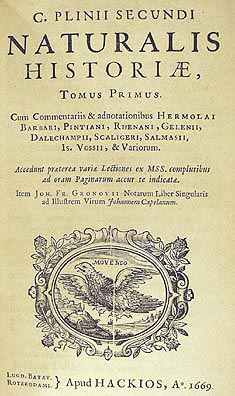
The Natural History is a work by Pliny the Elder. The largest single work to have survived from the Roman Empire to the modern day, the Natural History compiles information gleaned from other ancient authors. Despite the work's title, its subject area is not limited to what is today understood by natural history; Pliny himself defines his scope as "the natural world, or life". It is encyclopedic in scope, but its structure is not like that of a modern encyclopedia. It is the only work by Pliny to have survived, and the last that he published. He published the first 10 books in AD 77, but had not made a final revision of the remainder at the time of his death during the AD 79 eruption of Vesuvius. The rest was published posthumously by Pliny's nephew, Pliny the Younger.

The skvader is a Swedish fictional creature that was constructed in 1918 by the taxidermist Rudolf Granberg and is permanently displayed at the museum at Norra Berget in Sundsvall. It has the forequarters and hindlegs of a European hare, and the back, wings and tail of a female wood grouse. It was later jokingly given the Latin name Tetrao lepus pseudo-hybridus rarissimus L.

The catoblepas is a legendary creature from Ethiopia (Africa), first described by Pliny the Elder and later by Claudius Aelianus.
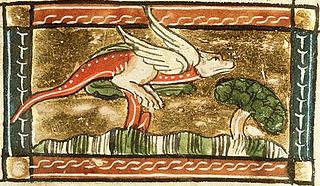
The jaculus is a small mythical serpent or dragon. It can be shown with wings and sometimes has front legs. It is also sometimes known as the javelin snake.
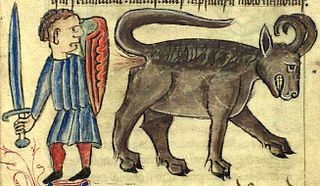
The bonnacon is a legendary creature described as a bull with inward-curving horns and a horse-like mane. Medieval bestiaries usually depict its fur as reddish-brown or black. Because its horns were useless for self-defense, the bonnacon was said to expel large amounts of caustic feces from its anus at its pursuers, burning them and thereby ensuring its escape.

The crocotta or corocotta, crocuta, or leucrocotta is a mythical dog-wolf of India or Aethiopia, linked to the hyena and said to be a deadly enemy of men and dogs.

Manduria is a city and comune of Apulia, Italy, in the province of Taranto. With c. 32,000 inhabitants (2013), it is located 35 kilometres (22 mi) east of Taranto.

Niels Klim's Underground Travels, originally published in Latin as Nicolai Klimii Iter Subterraneum (1741), is a satirical science-fiction/fantasy novel written by the Norwegian-Danish author Ludvig Holberg. His only novel, it describes a utopian society from an outsider's point of view, and often pokes fun at diverse cultural and social topics such as morality, science, sexual equality, religion, governments, and philosophy.
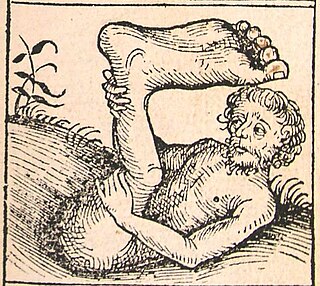
Monopods were mythological dwarf-like creatures with a single, large foot extending from a leg centred in the middle of their bodies. The names monopod and skiapod (σκιάποδες) are both Greek, respectively meaning "one-foot" and "shadow-foot".

Genius Party are two anthology films made up of 12 short animated films from Studio 4°C. It was envisioned to form a single release.
The salamander is an amphibian of the order Urodela which, as with many real creatures, often has been ascribed fantastic and sometimes occult qualities by pre-modern authors not possessed by the real organism. The legendary salamander is often depicted as a typical salamander in shape with a lizard-like form, but is usually ascribed an affinity with fire, sometimes specifically elemental fire.

The Panotti were a mythical race of people, described as possessing large ears that covered their entire bodies.

A pard is the Greek word for the leopard, which is listed in Medieval bestiaries and in Pliny the Elder's book Natural History. Over the years, there have been many different depictions of the creature including some adaptations with and without manes and some in later years with shorter tails. However, one consistent representation shows them as large felines often with spots.
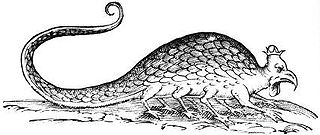
In European bestiaries and legends, a basilisk is a legendary reptile reputed to be a serpent king, who causes death to those who look into its eyes. According to the Naturalis Historia of Pliny the Elder, the basilisk of Cyrene is a small snake, "being not more than twelve inches in length", that is so venomous, it leaves a wide trail of deadly venom in its wake, and its gaze is likewise lethal.
The Cleveland Apollo is a 4th-century BCE life-size bronze statue, now in the Cleveland Museum of Art. It has acquired it in 2004 using the Severance and Greta Millikin Purchase
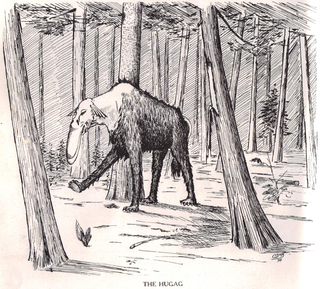
In American folklore, the hugag is a fearsome critter resembling a hippopotamus with an extensive upper-lip, preventing it from grazing, and joint-less legs preventing it from lying down.

A tarand, also known as a tarandos, tarandus, parandrus, or parandros, is a legendary reindeer/moose-like creature with chameleon properties. It was first described in Aristotle's Corpus Aristotelicum as Tarandos (Τάρανδος). It was also mentioned in Pliny's History of the Animals (Tarandus), Aelian's De Natura Animalium (Tarandos), Solinus (Parandrus) and Caesar, appearing again in key texts of the medieval period, such as The York Mystery Cycle (1440) and Francois Rabelais' Pantagruel (1552). The veracity of the tarand was discussed by Jean Léopold Nicolas Frédéric, Baron Cuvier (1769–1832).

















